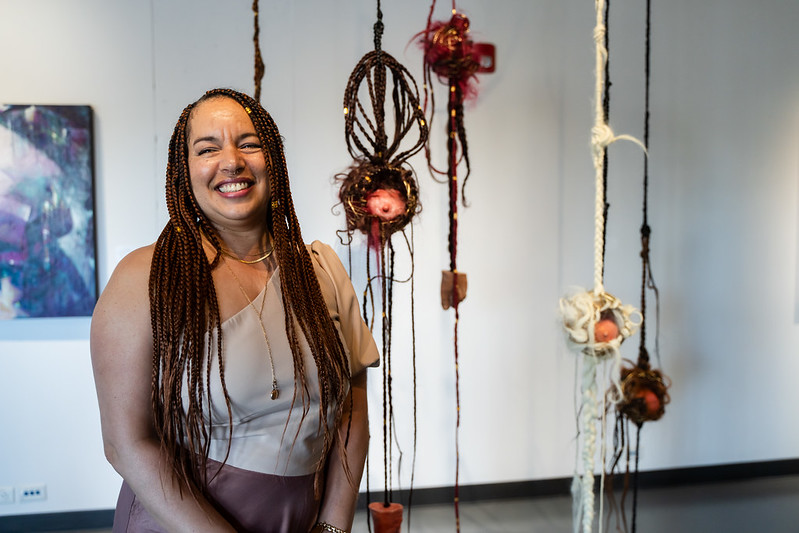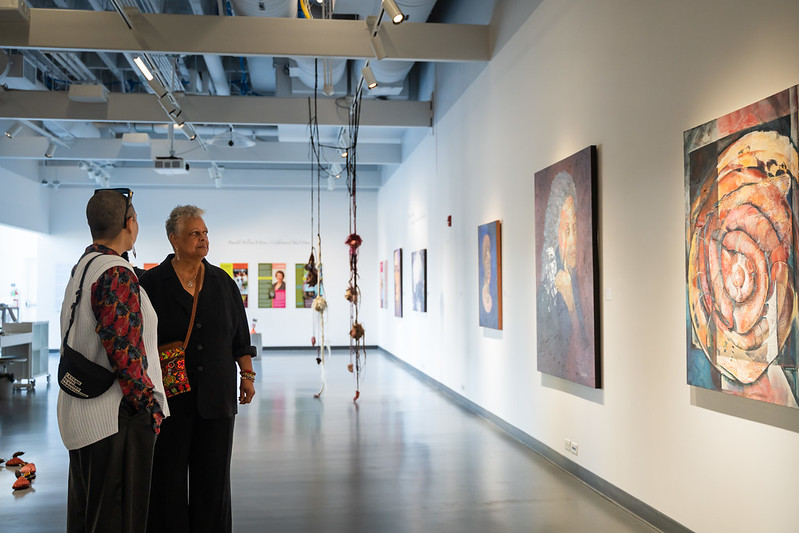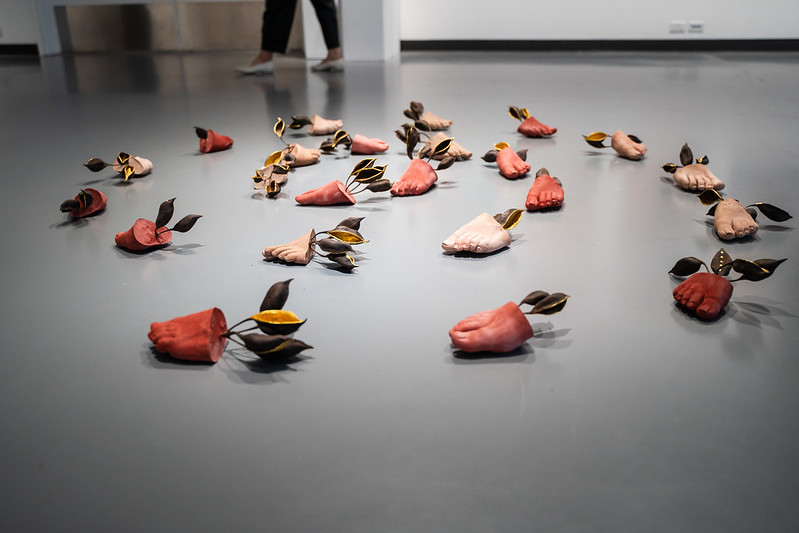This spring, Stara Lewis and Aisha Hollins orchestrated a captivating and deeply touching exhibit, Beautiful, Brilliant and Brave: A Celebration of Black Women. The exhibit showcased acrylic art creations by Jean Cornwell Wheat, textured visual artworks by Elizabeth Salaam, and a collection of posters honoring black women scholars meticulously assembled by Lewis and her daughter, Kora Dunbar.
Lewis elaborated that this display served as a continuation of the Women’s Museum at Liberty Station, showcasing a diverse array of artists. Curator Hollins collaborated intimately with the artists, meticulously choosing the finest pieces for the exhibit while delving into the artists’ narratives to ensure their stories were authentically conveyed.
Wheat and Salaam engaged with students, faculty, and guests during the speaker talk. This event was held on the second to last day of the exhibit as a commencement. Hollins encouraged them to delve into the inspiration and concepts behind their captivating artwork. Wheat initiated the discussion by elaborating on her acrylic paintings, starting with her artwork titled “The Snail.” This piece captivates viewers not just with its vibrant hues on a grand canvas, but also with its circular and spiral form, almost entrancing those who behold it.
Wheat shared the narrative behind “The Snail:” one rainy day in sunny San Diego, she found herself mesmerized by the sight of numerous snails creating intricate trails outside her residence. Their iridescent trails formed a mesmerizing pattern, inspiring her to translate this natural marvel onto her own canvas, crafting an art piece that mirrored the beauty she witnessed.
“There’s artists and there are normal people, and the snails were making art,” said Wheat.
“The Snail” represents life. It embodies the internal battles faced within oneself and the creation of personal vortexes within the mind. Wheat explained that as she began to incorporate textures and experiment with the canvas, her internal feelings became clearer to her.
“Sometimes it’s better to let go and let the universe direct you where to go,” added Wheat.
The allure of “The Snail” in the exhibit was not only due to its visual appeal but also because of its connection to another piece crafted by Salaam.
The artwork titled, “Bitch, I’m From Here” stood out prominently at the center of the exhibit as a physical spiral. It was a ceramic representation of Salaam’s feet, adorned in the same vibrant multicolor palette as “The Snail.” While Salaam didn’t delve into explicit details about this piece, its connection to “The Snail” was unmistakable. Both artworks shared a harmonious color palette of neutrals and pinks, as well as inner spirals, creating a cohesive aesthetic that intrigued viewers, further enhancing the coherence and resonance of the exhibition as a whole.
Salaam explained that the genesis of her pieces stemmed from a profound sense of displacement. Having grown up in Idaho with an adoptive family, she grappled with the sensation of being “non-existent,” as she described it. Channeling these emotions, she delved into the realm of visual arts, using it as a powerful outlet for self-expression. Her art pieces serve as encapsulations of her physical body, representing her breasts, feet, and mouth, each imbued with layers of personal significance and emotion.
Salaam recounted the process behind creating her textured pieces, highlighting one particular method called the “braiding party.” These were gatherings she hosted either at home or in shared spaces, inviting loved ones, strangers, and friends to partake in braiding using real braiding hair typically used in African American tradition. She said that these events provided her with a sense of visibility and understanding, filling a void she had long felt.
During Salaam’s portion of the talk, she also had a chance to describe the meaning of one of her more extravagant pieces: “The Mothership.” This piece features long braids hanging vertically, with some pieces intricately braided around ceramic replicas of Salaam’s breasts.
“The Mothership is the mythological mother, it’s the mythological motherland,” Salaam said.
“The Mothership” symbolizes her enduring sense of alienation and the environment that envelops it. The breasts signify her yearning for a maternal presence, compounded by her inability to experience breastfeeding due to being adopted. The braids carry cultural significance within the black community, emblematic of the meticulous care traditionally invested in hair — a dimension of childhood that Salaam reveals was absent. “The Mothership” symbolizes her mythical mother figure. She explains she has never felt a true sense of belonging, always carrying a profound feeling of homelessness.
Even though the artists couldn’t discuss each artwork individually, they captivated the attention of every visitor to the exhibit. Wheat and Salaam fostered a feeling of community, belonging, and affection within the San Diego Mesa Art Gallery. Cornwell’s timeless wisdom made it nearly irresistible to sit and converse with her for hours, while Salaam’s braiding parties inspired even those who couldn’t braid yearning for an invitation. As the gallery drew to a close, the guests departed with a deep sense of gratitude, extending our heartfelt wishes to the artists for their love and prosperity




